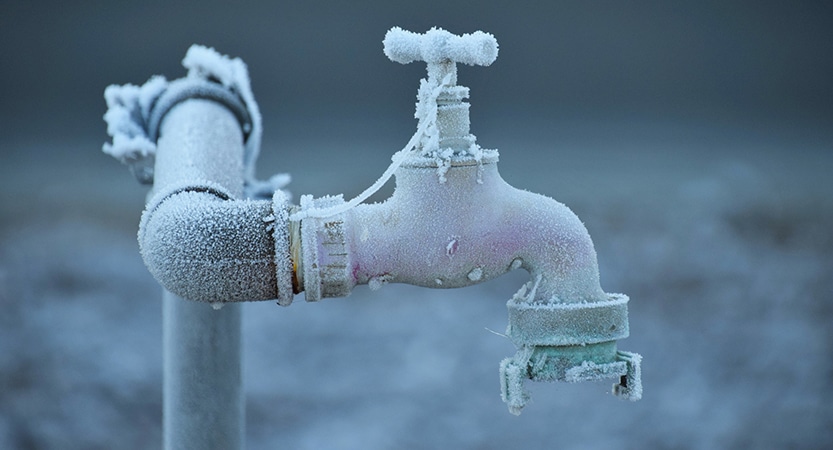Protecting Against Frozen Plumbing in Winter: Critical Advice
Protecting Against Frozen Plumbing in Winter: Critical Advice
Blog Article
What are your opinions with regards to 6 Ways to Prevent Frozen Pipes?

Winter can ruin your plumbing, particularly by freezing pipelines. Below's how to stop it from occurring and what to do if it does.
Introduction
As temperatures drop, the danger of icy pipes rises, potentially resulting in pricey repair services and water damage. Recognizing how to stop frozen pipelines is essential for home owners in cold environments.
Prevention Tips
Shielding prone pipelines
Wrap pipelines in insulation sleeves or use warm tape to safeguard them from freezing temperatures. Concentrate on pipes in unheated or external areas of the home.
Heating methods
Keep interior spaces sufficiently heated, specifically areas with plumbing. Open cupboard doors to allow cozy air to circulate around pipelines under sinks.
How to identify frozen pipelines
Try to find decreased water flow from taps, uncommon odors or noises from pipes, and noticeable frost on exposed pipes.
Long-Term Solutions
Architectural modifications
Take into consideration rerouting pipes away from exterior walls or unheated locations. Add added insulation to attic rooms, cellars, and crawl spaces.
Upgrading insulation
Purchase top notch insulation for pipelines, attics, and wall surfaces. Correct insulation assists maintain regular temperatures and reduces the risk of frozen pipes.
Securing Exterior Pipes
Garden pipes and outside taps
Disconnect and drain pipes garden tubes prior to winter months. Install frost-proof spigots or cover outside faucets with shielded caps.
Comprehending Frozen Pipes
What causes pipes to ice up?
Pipelines ice up when exposed to temperatures listed below 32 ° F (0 ° C) for prolonged durations. As water inside the pipelines ices up, it increases, putting pressure on the pipe wall surfaces and potentially triggering them to burst.
Dangers and problems
Icy pipelines can lead to water interruptions, property damage, and costly fixings. Ruptured pipes can flood homes and cause substantial structural damage.
Indicators of Frozen Pipes
Recognizing icy pipelines early can stop them from breaking.
What to Do If Your Pipelines Freeze
Immediate activities to take
If you think frozen pipes, maintain taps available to soothe stress as the ice thaws. Use a hairdryer or towels soaked in hot water to thaw pipes gradually.
Final thought
Stopping frozen pipelines calls for proactive steps and fast actions. By recognizing the causes, indications, and preventive measures, homeowners can protect their pipes throughout cold weather.
5 Ways to Prevent Frozen Pipes
Drain Outdoor Faucets and Disconnect Hoses
First, close the shut-off valve that controls the flow of water in the pipe to your outdoor faucet. Then, head outside to disconnect and drain your hose and open the outdoor faucet to allow the water to completely drain out of the line. Turn off the faucet when done. Finally, head back to the shut-off valve and drain the remaining water inside the pipe into a bucket or container. Additionally, if you have a home irrigation system, you should consider hiring an expert to clear the system of water each year.
Insulate Pipes
One of the best and most cost-effective methods for preventing frozen water pipes is to wrap your pipes with insulation. This is especially important for areas in your home that aren’t exposed to heat, such as an attic. We suggest using foam sleeves, which can typically be found at your local hardware store.
Keep Heat Running at 65
Your pipes are located inside your walls, and the temperature there is much colder than the rest of the house. To prevent your pipes from freezing, The Insurance Information Institute suggests that you keep your home heated to at least 65 degrees, even when traveling. You may want to invest in smart devices that can keep an eye on the temperature in your home while you’re away.
Leave Water Dripping
Moving water — even a small trickle — can prevent ice from forming inside your pipes. When freezing temps are imminent, start a drip of water from all faucets that serve exposed pipes. Leaving a few faucets running will also help relieve pressure inside the pipes and help prevent a rupture if the water inside freezes.
Open Cupboard Doors
Warm your kitchen and bathroom pipes by opening cupboards and vanities. You should also leave your interior doors ajar to help warm air circulate evenly throughout your home.

As a serious person who reads about How To Avoid Freezing Pipes, I assumed sharing that excerpt was necessary. So long as you enjoyed our page kindly don't forget to share it. We cherish your readership.
Schedule Now Report this page